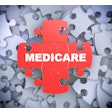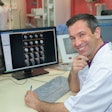
While some radiologists may still be concerned that artificial intelligence (AI) will replace them, the reality is that AI will help radiologists keep pace with imaging workflow demands -- especially as the volume of medical imaging exams grows.
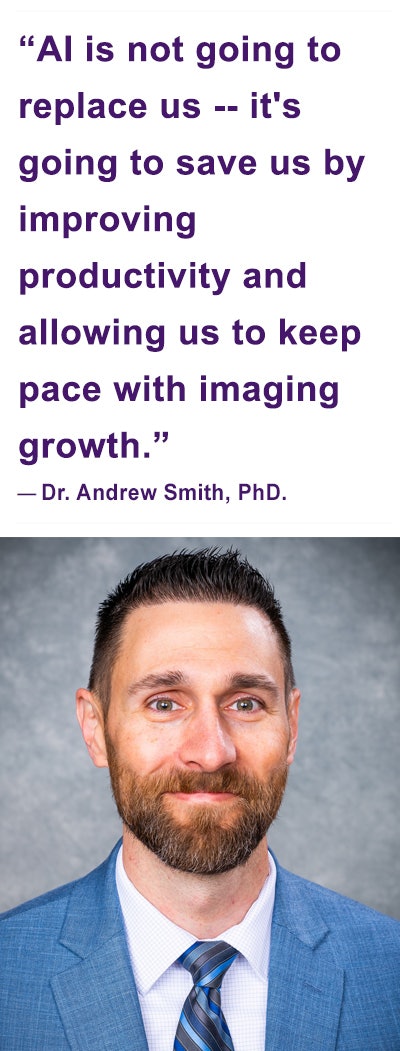
The volume of radiology studies is growing at an inexorable pace, even as the number of trained radiologists remains about the same in most developed countries. Something has to give unless a solution is found -- and many imaging experts believe that solution could be the increased adoption of AI for a variety of tasks.
"We are increasing the number of medical imaging exams by 4%-5% every year, and this pace is expected to continue, but we're not continuously increasing the number of graduating radiologists," said Dr. Andrew Smith, PhD, vice chair of clinical research at the University of Alabama Birmingham. "AI is not going to replace us -- it's going to save us by improving productivity and allowing us to keep pace with imaging growth."
Radiologists must have methods to improve productivity to stay relevant, but they also need solutions that improve accuracy, reduce errors, and increase standardization, added Smith, who is also the founder of AI Metrics, a technology startup focused on augmented intelligence, or the use of AI to improve human performance.
Dr. Constance Lehman, PhD, the division chief of breast imaging at Massachusetts General Hospital, concurs with Smith.
"We're being asked to do more work with fewer people, so we must become more efficient," she said. "We're also challenged by human variation in performance. We can build a great machine to take amazing images, but it's subject to the expertise of the person who's performing and reporting the exam. We also have significant challenges to shift from outdated fee-for-service models to value-based care, to deliver high-quality care at lower costs. All three of these domains are ones where smart computers can help us."
AI expert Dr. Paul Chang agrees and said the fact there's a discussion around how AI affects productivity is a reflection the field is moving from its infancy into its adolescence.

"Now that people are talking about AI and leveraging it for productivity, we're getting past the initial hype and getting into how we can really use AI for truly meaningful impact," said Chang, who is professor and vice chair of radiology informatics at the University of Chicago School of Medicine. "AI applications that positively impact productivity and efficiency are not just 'nice to haves' but 'must haves' the C-suite actually cares about. It's a good sign and shows we're slowly maturing into the appropriate consumption of AI."
AI's transition and transformation continues to prove the technology is here to stay -- there's no question about that. But how can radiologists, and administrative leaders in radiology programs and departments, choose wisely on which tools they should be using?
A multinational team of authors produced guidelines in March to help with just that, but fundamentally it comes down to the issues each practice is having and how AI can solve them. However, even that is not so simple because "in practical use, we're still in the Wild West and there's a lot of smoke and mirrors," Lehman said.
What AI applications are the radiologists most excited about and use themselves? They fall into four categories: triage, natural language processing (NLP), workflow, and augmented intelligence.
AI for triage
"Of the current FDA-cleared tools, the most popular category is computer-aided triage," according to Dr. Peter Chang, who is the co-director of the Center for Artificial Intelligence in Diagnostic Medicine at the University of California, Irvine.
These AI algorithms are aimed at sifting through a large number of patients to discover the ones with positive findings that need urgent attention, such as in the cases of stroke, pulmonary embolism (PE), fracture, and hemothorax, added Chang, who is also a co-founder of AI software developer Avicenna.AI.
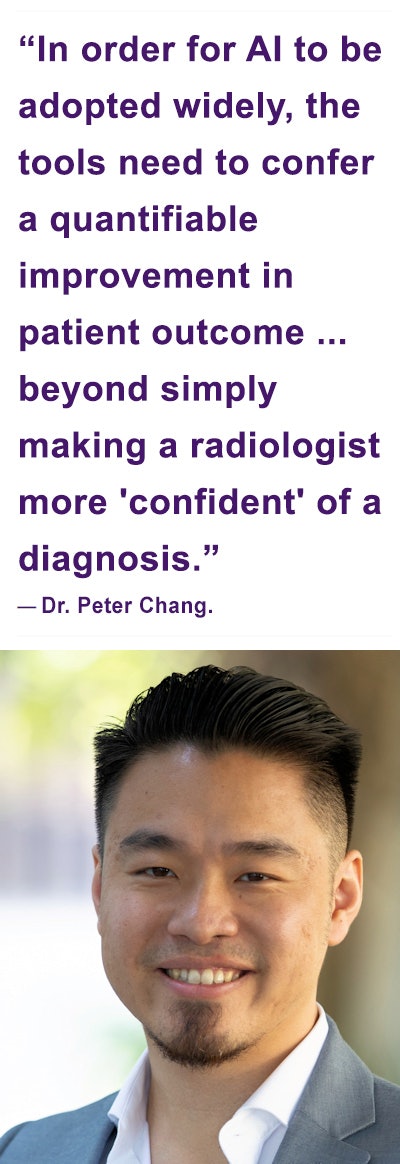
"In order for AI to be adopted widely, the tools need to confer a quantifiable improvement in patient outcome and/or financial benefit to the hospital beyond simply making a radiologist more 'confident' of a diagnosis," he said. "The radiologist is simply one member of an entire team involved in patient care -- for AI to truly impact the bottom line, it needs to yield tangible benefits at multiple steps in the process."
For instance, in the case of stroke, a clinical stroke team manages the patient and if AI is used, it very clearly affects the speed at which patients are moved into an operating room and improves clinical outcomes, according to Chang. Such applications are among the first to be reimbursed under the new technology add-on payment (NTAP) program from the U.S. Food and Drug Administration.
Imaging services provider Radiology Partners (RP) also uses AI and computer-aided detection (CAD) triage tools. The company has partnered with AI software developer Aidoc after piloting that company's intracranial hemorrhage (ICH) and PE triage models. In that six-month trial, radiologists were 11% more efficient in reading noncontrast head CT scans and 12% more efficient in reading CT pulmonary angiograms, according to Dr. Nina Kottler, associate chief medical officer for clinical AI at Radiology Partners.
"CAD triage models are supposed to help rads get to the exam faster, not read it faster, but it did," she said. "The reason for the improvement is related to the tool's high negative predictive value and the fact most exams don't have any ICH or PE. The software improved the efficiency in reading negative studies. Radiologists didn't ruminate because they looked at the exam and AI looked at it too."
The AI tool also helped radiologists at RP become more sensitive to subtle findings, increasing their accuracy, she added.
Dr. Paul Chang, too, sings the praises of leveraging AI to improve radiologist's workflow.
"When we look at what the radiologist does in the reading room, we are constantly required to perform many tedious and trivial tasks in order to interpret imaging studies," he said. "Humans are generally not particularly good at these tedious tasks. I'm mentally exhausted at the end of the day because I'm spending too much time rearranging images, measuring lesions, and playing childish games like 'Where's Waldo?' We have an immense opportunity to leverage AI to perform these tasks and let humans concentrate on what's more important."
AI for natural language processing
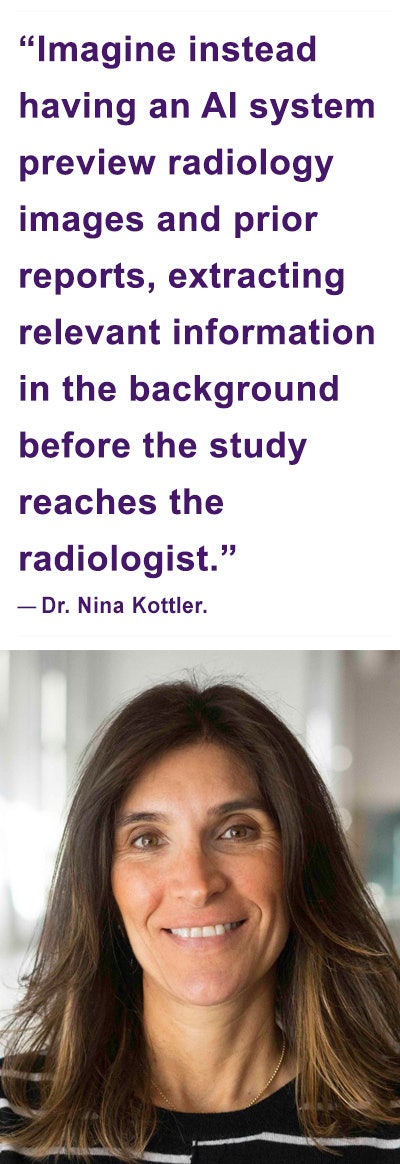
Another place where AI has achieved great success for RP and other radiology practices is with natural language processing (NLP). In 2017, RP created a real-time NLP best-practice program to provide radiologists with population health-based follow-up recommendations for different pathologies, like abdominal aortic aneurysms. RP already had a best-practice program, but it required radiologists to remember that there's a best practice and then look up the follow-up appropriate for that patient.
To solve this problem, Radiology Partners created NLP AI with a decision tree. This ended up saving huge amounts of time because the radiologist didn't have to look everything up and instead could simply verify the results.
"It gave radiologists the opportunity to be more efficient and effective," Kottler said. "Radiologists were resuming the role of the physician's consultant, enabling our referring clinicians to take better care of their patients. More important than efficiency, it added value."
Smith echoed Kottler's statements. AI can reduce misses, increase the speed of image analysis and reporting, and improve turnaround time in the emergency department, he said. NLP algorithms can automate a radiology report's conclusion using dictated text from the findings section of the report, which can reduce omission of important findings in the conclusion and improve overall performance, he added.
AI for workflow
Dr. Eliot Siegel of the University of Maryland said AI has great potential as an intelligent workflow orchestrator.
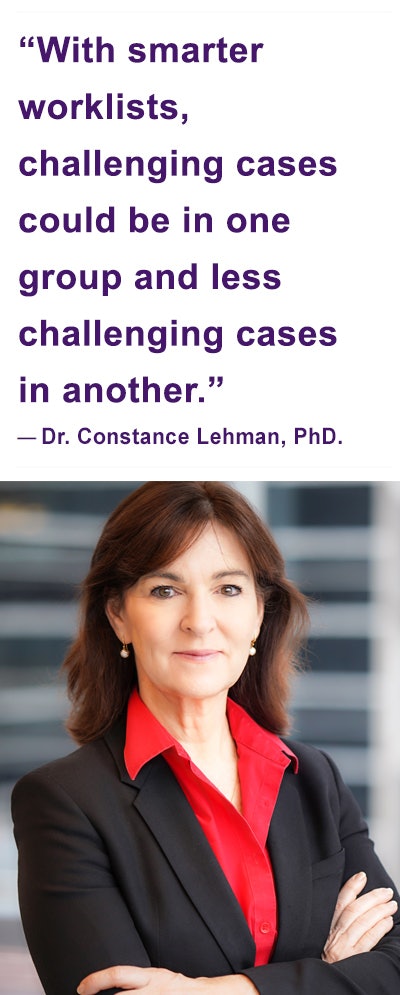
"Essentially it could assign radiologists cases that would be most appropriate, optimize the workflow, and then have a way of tracking and rewarding the radiologist that is the most productive and has the highest level of expertise," said Siegel, who is professor and vice chair of the department of diagnostic radiology at the University of Maryland School of Medicine, as well as chief of radiology and nuclear medicine for the Veterans Affairs Maryland Healthcare System.
AI can distribute the right images to the right radiologists at the right time, which will allow them to be able to improve workflow and productivity in a typical radiology department because right now, some radiologists are being underutilized, he said.
Lehman added that in her field of women's imaging, with mammograms in particular, images are read as they are acquired throughout the day and in big batches, which may not be optimal.
"With smarter worklists, challenging cases could be in one group and less challenging cases in another," she said. "AI can also help with who should read these cases because general radiologists are terrific at reading most mammograms, but if a case is challenging, sometimes they don't know how to interpret it and that can kill productivity and performance. Using an AI algorithm, if there's almost no chance there's a cancer on the mammogram, it can be in a stack that the general radiologist goes through more effectively and more efficiently. This is just one example of how a local practice might leverage AI tools to improve workflow and outcomes."
AI and augmented intelligence
The final area where radiologists are excited in the field of AI is augmented intelligence, which sometimes combines image viewing, analysis, and reporting. With augmented intelligence focused on cancer, for instance, an AI algorithm can segment and automate target lesion measurements, annotate nontarget lesions, force follow-up of important findings, and automatically generate a report.
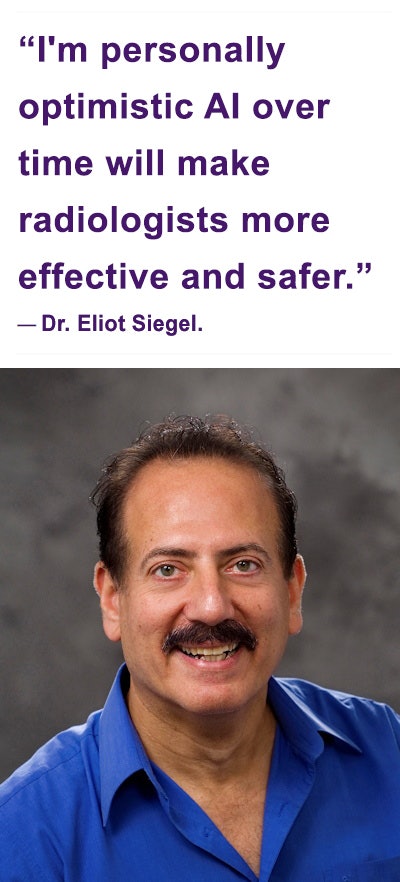
The augmented intelligence viewer and reporting system from AI Metrics can double efficiency and simultaneously improve accuracy by 25%, reduce major errors by 99%, and increase interobserver agreement by 54% when evaluating and reporting on advanced cancer response to therapy, according to Smith.
"You can hit a button and the report is done, everything is digitized," Smith said. "It's 50% faster to get to that report and those are numbers that matter. Even if you use the algorithm on only 10%-20% of your workload, that could be an hour a day saved."
This is what AI is good at -- extracting structured information from unstructured data, Kottler said. Normally, value cannot be derived from unstructured data without expert human review.
"Imagine instead having an AI system preview radiology images and prior reports, extracting relevant information in the background before the study reaches the radiologist," she said. "Just like our real-time NLP system, the radiologist could then validate the extracted data and provide context to our referring clinicians so they can best care for their patients."
It would cause such an improvement that the day-to-day life of a radiologist could change, making it easier and less of a burnout environment, Siegel said.
"I'm personally optimistic AI over time will make radiologists more effective and safer," he said. "I think it will change the task of radiologists from one that is predominantly findings based, which can be fairly tedious and fairly stressful, to one that is much more judgment based."


















